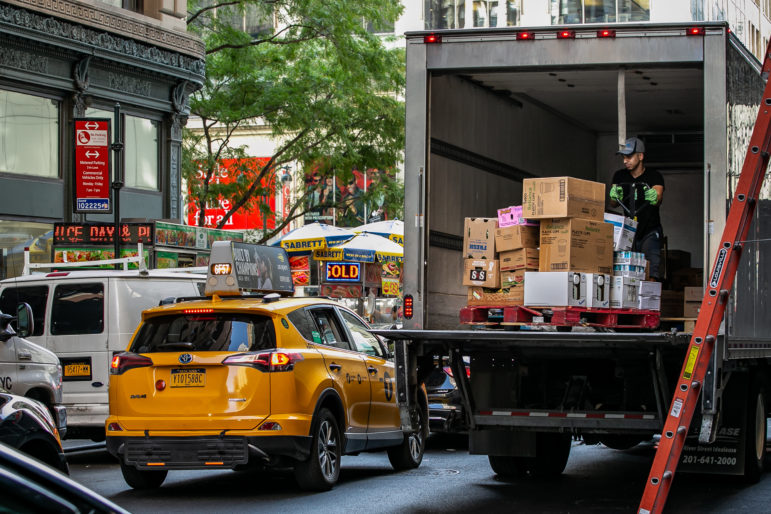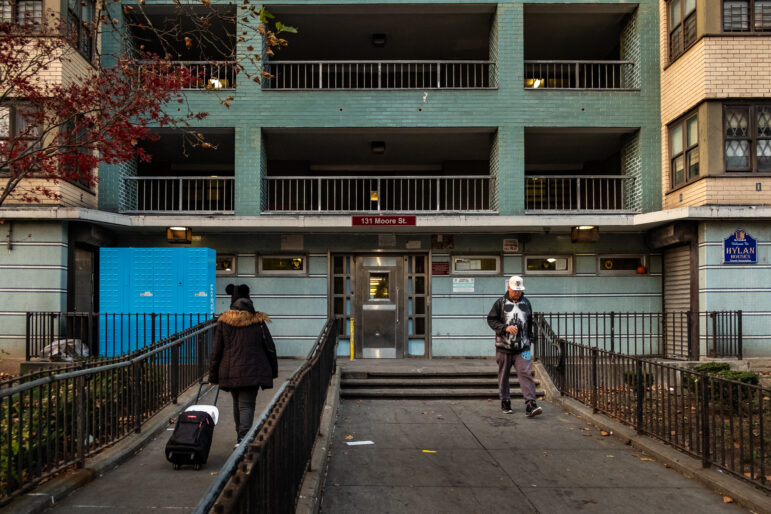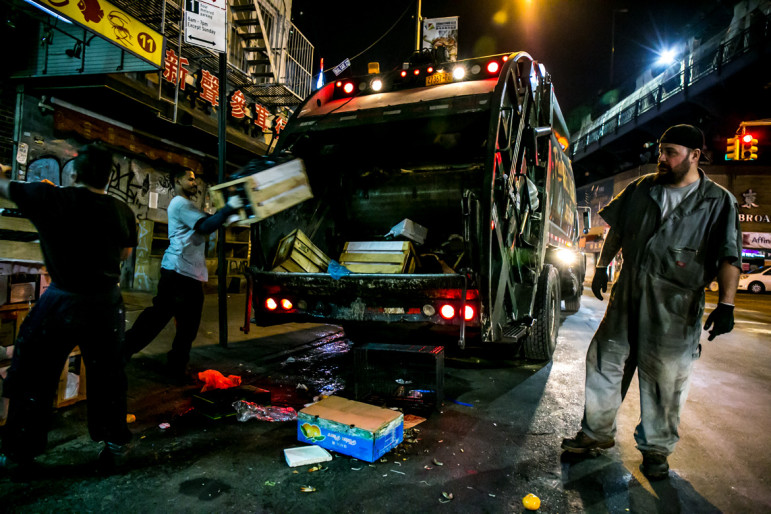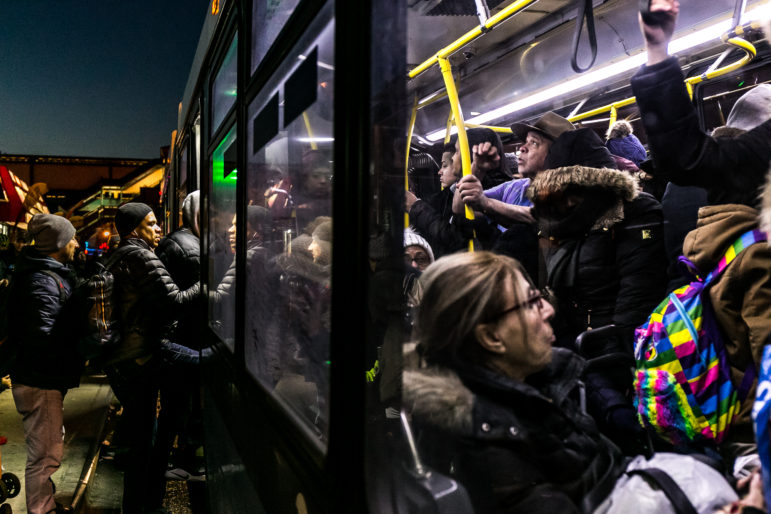“In its current form, the state’s congestion pricing plan falls short of meaningfully addressing impacts on New York’s disabled community—a community the MTA has neglected for decades.”

City Limits / Adi Talwar
West 33nd Street near 6th Avenue in Midtown Manhattan.Congestion pricing is missing a critical opportunity to do right by a community long overlooked by the Metropolitan Transit Authority (MTA): disabled New Yorkers.
In its current form, the state’s congestion pricing plan falls short of meaningfully addressing impacts on New York’s disabled community—a community the MTA has neglected for decades. Going into effect as soon as 2023, the plan touts more than $1 billion in revenue but continues to build upon the MTA’s legacy of allowing the needs of disabled New Yorkers to continually fall further down their list of priorities.
The problem is twofold: the new plan attempts to prevent the use of cars—a method of transportation that disabled New Yorkers, like me, rely on every day—but fails to invest in or even offer reliable, viable alternatives. For over a year following my 2013 subway accident, I was unable to take the subway or any form of public transportation due to the fact that stations and buses near my apartment, office, doctors, and all other aspects of daily life were inaccessible.
Almost 10 years later, little has changed. While we saw the first fully accessible subway line opened with the Q-train, as well as elevators and other accessibility tools, hundreds of stations across the five boroughs remain inaccessible. Overall, barely 25 percent of the system citywide is “accessible.” And this is the system the MTA is telling disabled New Yorkers to rely on as an alternative to driving or taking a for-hire vehicle. How, exactly, are we supposed to get around under this new plan?
The MTA’s spending priorities illustrate why we can’t trust that they’re prepared to meaningfully address accessibility. The MTA has routinely funded new items in recent years like platform multimedia screens, station artwork, and other comparatively unnecessary expenses without addressing long overdue accessibility improvements.
What’s worse, to avoid these improvements, the MTA regularly seeks compliance waivers for the Americans with Disabilities Act. Their role in keeping the system inaccessible is undeniable. A few years ago, renovations to subway stations between Queensboro Plaza and Ditmars Boulevard in Queens included millions of dollars for new signs and mosaic tiles, but failed to add any elevators, escalators, or other accessibility tools during this major construction.
Congestion pricing proponents continually tout how great this policy will be for disabled New Yorkers, but it remains vague—at best—on how it will ensure that’s the reality. The new plan includes an exemption for vehicles carrying people with disabilities and residents of the congestion zone who earn $60,000 or less annually, but it fails to include or create a mechanism to enforce or apply the provision. Am I to wave my cane out of my car window to signify the vehicle is carrying a passenger with a disability to avoid the congestion fee? What about people with invisible disabilities or chronic illnesses who can’t rely on the transit system and don’t have a mobility aid to show? How will the MTA ensure they receive the exemption the law includes?
We also can’t ignore the financial impact that the congestion fee, proposed to be up to $23 each way, will have on disabled New Yorkers. Disabled people experience disproportionately high rates of unemployment, as well as strict income and financial limits for public and healthcare benefits, and are more likely to live at or below the federal poverty line than non-disabled people. Paying a $23 fee each way to see a doctor, visit family, or enjoy the city we call home is a financial barrier many won’t be able to get past, which threatens to further isolate and segregate disabled people.
The exemption offered based on income fails to address this. To qualify, you must make below $60,000 AND have a primary residence within the congestion zone. But with over one million disabled adults and children in New York City—a majority of whom live well outside the congestion zone—this income threshold tied to residence is grossly insufficient to address the needs and lived reality of New Yorkers who can’t use our public transit system.
Disabilities vary and cannot be neatly categorized like congestion pricing is trying to do. To truly address these problems, we need a more holistic solution that includes expediting accessibility upgrades citywide. The truth is that transportation solutions are not the same for every disabled person and tying the exemption solely to Access-A-Ride, disabled parking placards, license plates, and ADA-compliant TLC and for-hire vehicles will disenfranchise countless disabled people who can’t rely on public transit.
Additionally, making disabled people go before the Department of Transportation (DOT) to prove their disability and “need” for an exemption isn’t a solution. The current ADA parking program run by the DOT regularly rejects disabled people who they deem not “disabled enough” while not being medical or legal professionals. We need an expedited exemption process created before tolling begins that is guided by the disability community and addresses the financial, healthcare, and transportation realities we face every day to get around the city we call home. This process and the exemption must then be fully implemented before tolling begins and enforced by the MTA and relevant agencies.
A policy of this magnitude cannot be implemented in a piecemeal or haphazard way at the expense of a group repeatedly harmed and overlooked by the MTA and our government. We all want less pollution, less congestion, and a better and, most importantly, fully accessible public transit system, just like the proponents of the program. But without careful enactment, the MTA will again ignore the needs and realities of disabled New Yorkers. Unfortunately, as it currently stands, the state’s congestion pricing plan not only fails to solve these problems—it will likely only make them worse.
Rebecca Lamorte is a New York City-based disability rights advocate and former candidate for the New York City Council in 2021.









One thought on “Opinion: Don’t Overlook Disabled New Yorkers in Congestion Pricing Plan”
Read all the “complaints” of each article from City
Limits. From my southern roots and heritage of 200 Years and from the small community of Duluth, Georgia everybody is a complainer in New York city. Everybody expects all of their silly problems to be fixed by a government source. I read in one the articles that the
city wants to spend billions to get rid of mold. Why don’t
the tenants just go out and buy a $3.00 can of mold
remover. Are you that lazy?
To all the New yorkers and all the new arrivals
we have a quote from President John F. Kennedy,
“Ask not what your country can do for you but
ask what you can do for your country”.
Cc : The blue ribbon of complainers is “The Disable”.